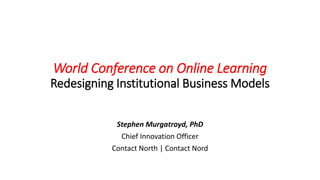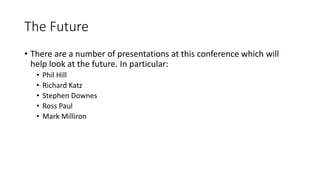Redesigning Institutional Business Models - Mini Keynote, World Conference on Online Learning
- 1. World Conference on Online Learning Redesigning Institutional Business Models Stephen Murgatroyd, PhD Chief Innovation Officer Contact North | Contact Nord
- 2. Secure New Markets Reimagine Business Processes Hyperscale Platforms for Global Reach Unconstrain Supply of Learning Supports Refining and Strengthening their Value Proposition
- 3. 1. Refining and Strengthening Their Value Proposition • Universities and colleges are being required to define and clarify who they are and what social, economic and personal impact they intend to have on their communities. Some governments have required this, but changes in demographics, markets, employer demands and technology also demand this. • Some have chosen to embrace a different future: • Shifting their models of teaching and learning from blended to fully online • Shifting from F2F to blended • Shifting from a limited range of programs to a broader range of programs • Seeking to leverage partnerships and alliances to offer joint programs leading to certificates, diplomas and degrees. • Not all of these redefinitions are working - private universities and colleges in many jurisdictions struggle to keep pace with market shifts and regulatory change. Closures in some markets (US, India, Africa) are significant and it is likely that more will follow. • A significant number of established institutions are also facing challenges - The OU UK and Athabasca - amongst them. Achieving financial sustainability requires them to fundamentally rethink their value proposition and reposition themselves in a fast changing market. • 22 UK Universities rely on student fees for over 65% of their revenues and are concerned that Brexit may affect their future.
- 4. 2: Reimagine Business Processes • Many are also looking at new ways of working - changing how they do business: • Unbundling analytics, IT and other services and spinning them off as separate entities - University College Maryland. • Moving from a limited number of entry points for programs to more frequent admissions, with Kentucky Community and Technical College System (KCTCS) offering learning for credit on demand (365 days a year x24 hour admission). • Moving from 3 or 6 credit university or college courses to micro credit - modular, stackable credentials - a large nunebr of institutions and many MOOC providers. • Using OER to offer badges, certificates, diplomas and degrees - in some cases supported by Blockchain technologies. • Growing use of OER and e-textbooks to reduce costs and increase the efficiency of course development - trying to develop online courses in days rather than weeks or months. • Using analytics to focus recruitment, increase retention and completion and continuously improve course quality and value.
- 5. Unconstrain Learning Supports • Some institutions are changing their models of student support: • More extensive use of peer to peer support and assessment • A growing use of machine intelligent support systems for assessment - both assessment generation and marking. • The use of learner analytics to suggest when an intervention might help retention and completion. • Innovative uses of chatbots and AI for tutoring, counselling and student support - the famous case of Georgia Tech’s Jill Watson. • Creative use of machine intelligent systems for student support services, such as that in use at the OU Hong Kong. • Consolidation of tutoring and academic support through help desk based models rather than course-by-course tutoring, such as AU’s Faculty of Business.
- 6. Hyperscale Platforms for Global Reach • Institutions are also thinking more globally, especially now that online programs can reach millions • MOOCs reached 56 million in 2016 and a growing number of these programs began to carry credit - it 2017 FutureLearn began to offer Masters degrees through MOOC’s in partnership with Deakin University. • University of Wisconsin and seven others now offer bachelor degrees by assessment only - competency based assessment. • As Transnational Qualifications Frameworks begin to have an impact, organizations like the Virtual University of the Small States of the Commonwealth become organizing entities for multinational programs libked to sustainable development. The International Telematic University centered in Italy (UNINETTUNO) is another example of this kind of development. • OERu, Open Learn from the OU UK are both further examples of this globalization.
- 7. Secure New Markets • There is a strong focus on new markets: • The growing number of seniors interested in learning, especially linked to languages, the acquisition of long-sought after skills and health-wellness. • A strong focus on education of girls and women, with some pioneering work being done at the Commonwealth of Learning. • Strong focus on coding, STEM and design disciplines - seeking to link these to new flexible programs that address the skills gaps which many countries are facing. See especially the work of Ecole42 in Paris and California. • Strong focus on recent immigrants and upgrading their qualifications.
- 8. 5 Constraints • Austerity which impacts government funding for public institution. • The neo-liberal agenda of competition and privatization - see especially developments in the US and UK • Faculty Development Investment • Accountability and Market Regulation • Quality Assurance Regimes • Leadership Capabilities
- 9. The Future • There are a number of presentations at this conference which will help look at the future. In particular: • Phil Hill • Richard Katz • Stephen Downes • Ross Paul • Mark Milliron
- 10. Two Big Questions 1. What are the implications of organizational change for the role of Faculty? • A lot depends on them - are they ready? 2. Would collaboration and co-operation do more for learners than institutional competition for market share? • GeRM versus Equity.
Editor's Notes
- For more on the use of IBM Watson see https://thenextweb.com/shareables/2016/05/13/computer-science-class-fails-notice-ta-actually-ai-chatbot/










